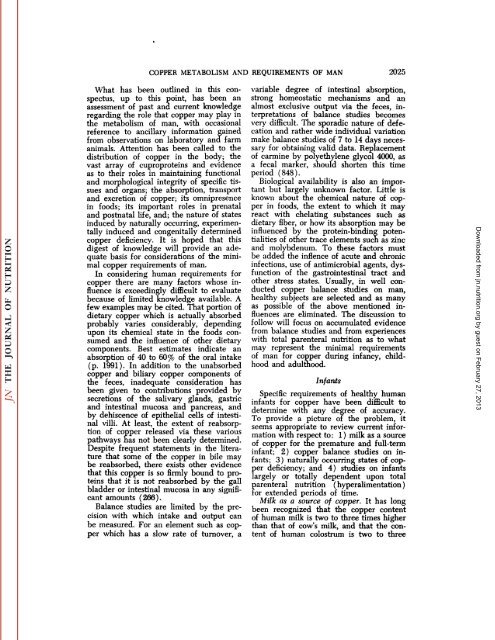conspectus of researchon copper metabolism and requirements
conspectus of researchon copper metabolism and requirements
conspectus of researchon copper metabolism and requirements
You also want an ePaper? Increase the reach of your titles
YUMPU automatically turns print PDFs into web optimized ePapers that Google loves.
COPPER METABOLISM AND REQUIREMENTS OF MAN 2025<br />
What has been outlined in this con<br />
spectus, up to this point, has been an<br />
assessment <strong>of</strong> past <strong>and</strong> current knowledge<br />
regarding the role that <strong>copper</strong> may play in<br />
the <strong>metabolism</strong> <strong>of</strong> man, with occasional<br />
reference to ancillary information gained<br />
from observations on laboratory <strong>and</strong> farm<br />
animals. Attention has been called to the<br />
distribution <strong>of</strong> <strong>copper</strong> in the body; the<br />
vast array <strong>of</strong> cuproproteins <strong>and</strong> evidence<br />
as to their roles in maintaining functional<br />
<strong>and</strong> morphological integrity <strong>of</strong> specific tis<br />
sues <strong>and</strong> organs; the absorption, transport<br />
<strong>and</strong> excretion <strong>of</strong> <strong>copper</strong>; its omnipresence<br />
in foods; its important roles in prenatal<br />
<strong>and</strong> postnatal life, <strong>and</strong>; the nature <strong>of</strong> states<br />
induced by naturally occurring, experimen<br />
tally induced <strong>and</strong> congenitally determined<br />
<strong>copper</strong> deficiency. It is hoped that this<br />
digest <strong>of</strong> knowledge will provide an ade<br />
quate basis for considerations <strong>of</strong> the mini<br />
mal <strong>copper</strong> <strong>requirements</strong> <strong>of</strong> man.<br />
In considering human <strong>requirements</strong> for<br />
<strong>copper</strong> there are many factors whose in<br />
fluence is exceedingly difficult to evaluate<br />
because <strong>of</strong> limited knowledge available. A<br />
few examples may be cited. That portion <strong>of</strong><br />
dietary <strong>copper</strong> which is actually absorbed<br />
probably varies considerably, depending<br />
upon its chemical state in the foods con<br />
sumed <strong>and</strong> the influence <strong>of</strong> other dietary<br />
components. Best estimates indicate an<br />
absorption <strong>of</strong> 40 to 60% <strong>of</strong> the oral intake<br />
(p. 1991). In addition to the unabsorbed<br />
<strong>copper</strong> <strong>and</strong> biliary <strong>copper</strong> components <strong>of</strong><br />
the feces, inadequate consideration has<br />
been given to contributions provided by<br />
secretions <strong>of</strong> the salivary gl<strong>and</strong>s, gastric<br />
<strong>and</strong> intestinal mucosa <strong>and</strong> pancreas, <strong>and</strong><br />
by dehiscence <strong>of</strong> epithelial cells <strong>of</strong> intesti<br />
nal villi. At least, the extent <strong>of</strong> reabsorption<br />
<strong>of</strong> <strong>copper</strong> released via these various<br />
pathways has not been clearly determined.<br />
Despite frequent statements in the litera<br />
ture that some <strong>of</strong> the <strong>copper</strong> in bile may<br />
be reabsorbed, there exists other evidence<br />
that this <strong>copper</strong> is so firmly bound to pro<br />
teins that it is not reabsorbed by the gall<br />
bladder or intestinal mucosa in any signifi<br />
cant amounts (266).<br />
Balance studies are limited by the pre<br />
cision with which intake <strong>and</strong> output can<br />
be measured. For an element such as cop<br />
per which has a slow rate <strong>of</strong> turnover, a<br />
variable degree <strong>of</strong> intestinal absorption,<br />
strong homeostatic mechanisms <strong>and</strong> an<br />
almost exclusive output via the feces, in<br />
terpretations <strong>of</strong> balance studies becomes<br />
very difficult. The sporadic nature <strong>of</strong> defe<br />
cation <strong>and</strong> rather wide individual variation<br />
make balance studies <strong>of</strong> 7 to 14 days neces<br />
sary for obtaining valid data. Replacement<br />
<strong>of</strong> carmine by polyethylene glycol 4000, as<br />
a fecal marker, should shorten this time<br />
period (848).<br />
Biological availability is also an impor<br />
tant but largely unknown factor. Little is<br />
known about the chemical nature <strong>of</strong> cop<br />
per in foods, the extent to which it may<br />
react with chelating substances such as<br />
dietary fiber, or how its absorption may be<br />
influenced by the protein-binding poten<br />
tialities <strong>of</strong> other trace elements such as zinc<br />
<strong>and</strong> molybdenum. To these factors must<br />
be added the inflence <strong>of</strong> acute <strong>and</strong> chronic<br />
infections, use <strong>of</strong> antimicrobial agents, dys<br />
function <strong>of</strong> the gastrointestinal tract <strong>and</strong><br />
other stress states. Usually, in well con<br />
ducted <strong>copper</strong> balance studies on man,<br />
healthy subjects are selected <strong>and</strong> as many<br />
as possible <strong>of</strong> the above mentioned in<br />
fluences are eliminated. The discussion to<br />
follow will focus on accumulated evidence<br />
from balance studies <strong>and</strong> from experiences<br />
with total parenteral nutrition as to what<br />
may represent the minimal <strong>requirements</strong><br />
<strong>of</strong> man for <strong>copper</strong> during infancy, child<br />
hood <strong>and</strong> adulthood.<br />
Infants<br />
Specific <strong>requirements</strong> <strong>of</strong> healthy human<br />
infants for <strong>copper</strong> have been difficult to<br />
determine with any degree <strong>of</strong> accuracy.<br />
To provide a picture <strong>of</strong> the problem, it<br />
seems appropriate to review current infor<br />
mation with respect to: 1) milk as a source<br />
<strong>of</strong> <strong>copper</strong> for the premature <strong>and</strong> full-term<br />
infant; 2) <strong>copper</strong> balance studies on in<br />
fants; 3) naturally occurring states <strong>of</strong> cop<br />
per deficiency; <strong>and</strong> 4) studies on infants<br />
largely or totally dependent upon total<br />
parenteral nutrition (hyperalimentation )<br />
for extended periods <strong>of</strong> time.<br />
Milk as a source <strong>of</strong> <strong>copper</strong>. It has long<br />
been recognized that the <strong>copper</strong> content<br />
<strong>of</strong> human milk is two to three times higher<br />
than that <strong>of</strong> cow's milk, <strong>and</strong> that the con<br />
tent <strong>of</strong> human colostrum is two to three<br />
Downloaded from<br />
jn.nutrition.org<br />
by guest on February 27, 2013
















